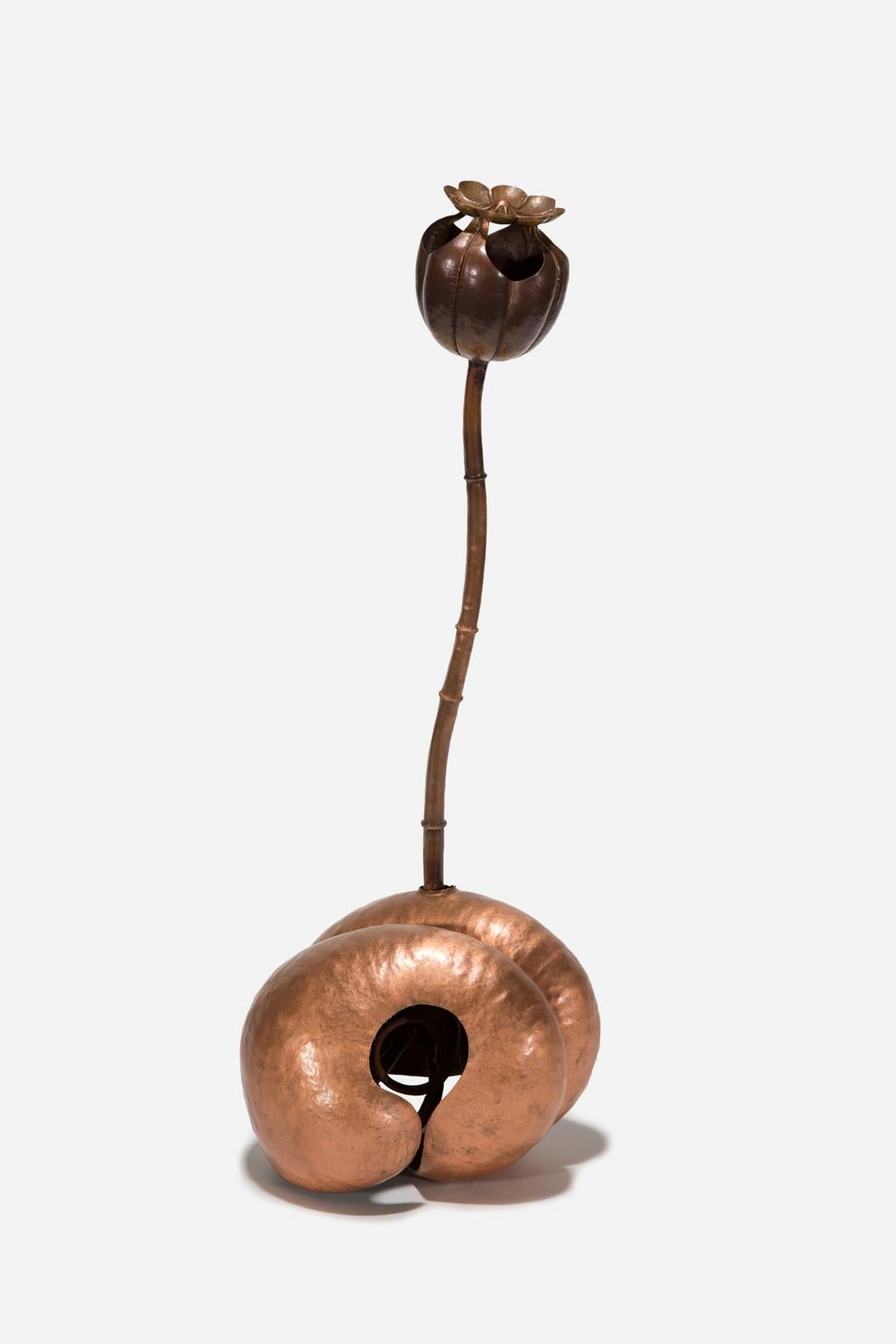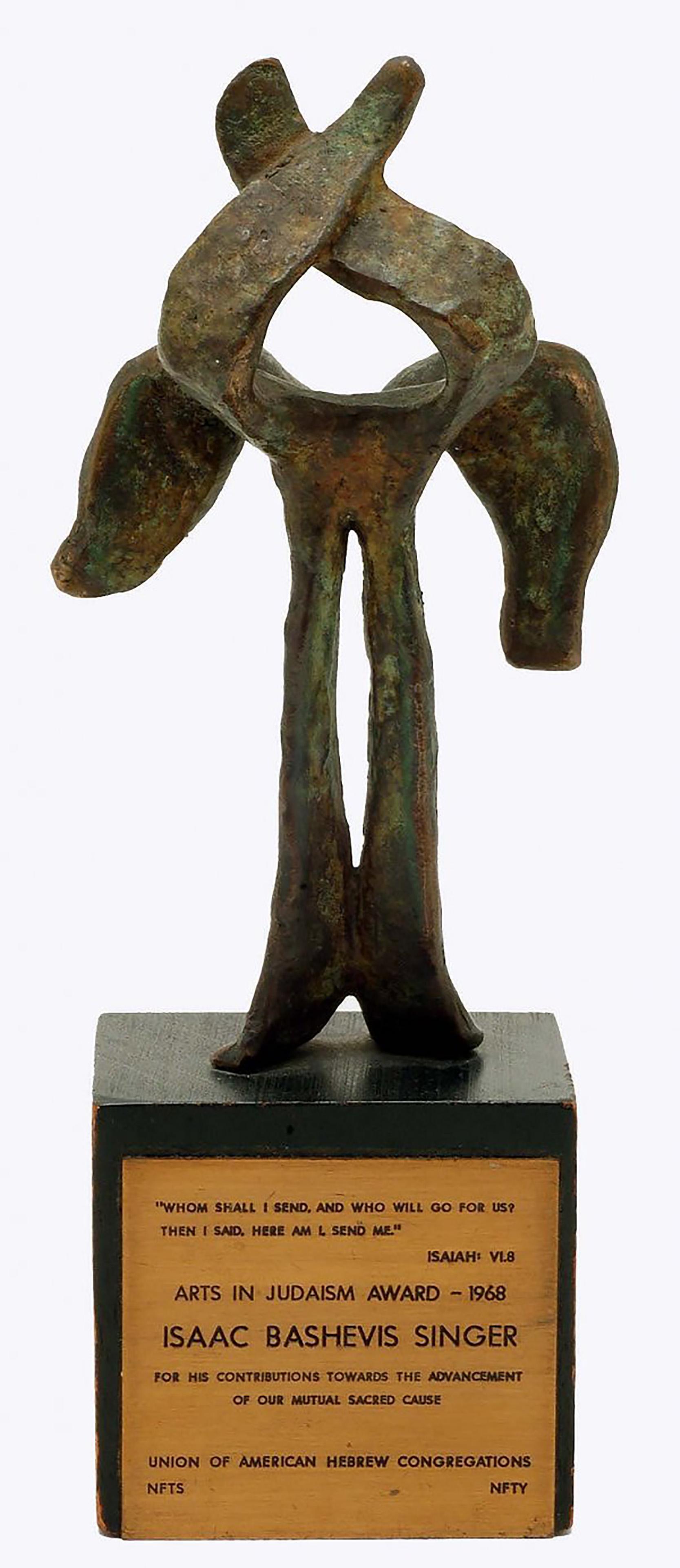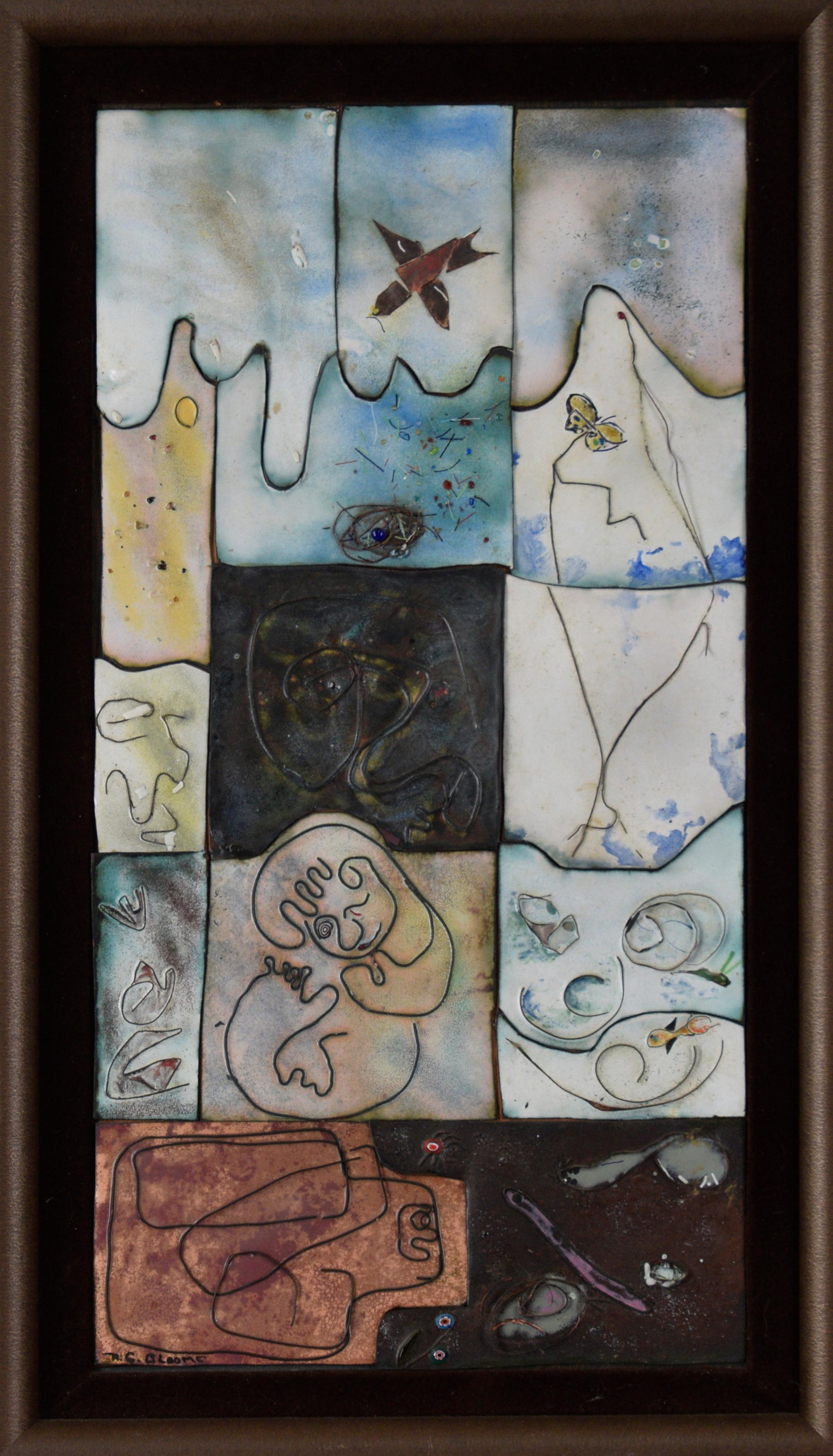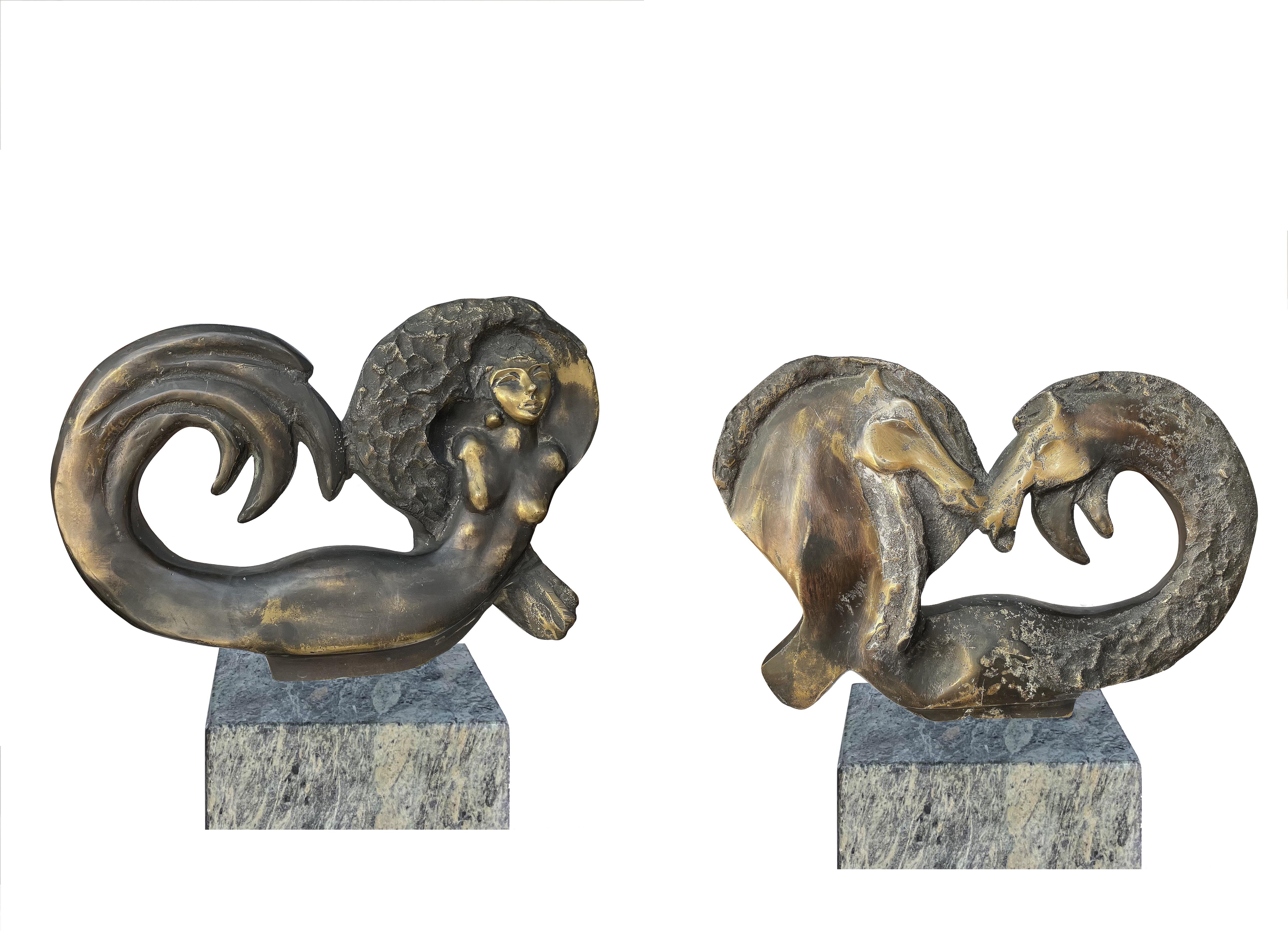Items Similar to Brutalist Bronze Abstract Modernist Sculpture
Want more images or videos?
Request additional images or videos from the seller
1 of 5
UnknownBrutalist Bronze Abstract Modernist Sculpture
About the Item
In the manner of Julio Gonzalez, mixed metal sculpture.
Neo-Dada Abstract Sculpture: Assemblages
Abstract sculpture followed a slightly different course. Rather than focusing on non-figurative subject matter, it concentrated on materials, hence the emergence of Assemblage Art - a form of three-dimensional visual art made from everyday objects, said to be 'found' by the artist (objets trouves). Popular in the 1950s and 1960s in America, assemblage effectively bridged the gap between collage and sculpture, while its use of non-art materials - a feature of Neo-Dada art - anticipated the use of mass-produced objects in Pop-Art. Assemblage sculpture is exemplified by the works of Louise Nevelson (1899-1988), such as Mirror Image 1 (1969, Museum of Fine Arts, Houston), and by Jean Dubuffet (1901-85) and his Monument with Standing Beast (1960, James R. Thompson Center, Chicago). The idiom was considerably boosted by an important exhibition - "The Art of Assemblage" - at the Museum of Modern Art, in New York, in 1961.
Other examples of the Neo-Dadaist-style "junk art" include Hudson River Landscape (1951, Whitney Museum of American Art) and Australia (1951, MoMA, NY), both by David Smith (1906-1965); Untitled (wood, metal pieces, nails) (1960, Museum of Modern Art NYC) by Jesus Rafael Soto (b.1923); and certain "combines" by Robert Rauschenberg (1925-2008), such as First Landing Jump (made from: painting, cloth, metal, leather, electric fixture, cable, oil paint, board) (1961, MoMA, NY). Untitled (industrial felt) (1967, Kunsthalle, Hamburg) by Robert Morris (b.1931) is a further example of the use of unusual materials in sculpture, as is the minimalist Monument For Vladimir Tatlin (neon-lighting tubes) (1975, Musee National d'Art Moderne, George Pompidou Centre) by Dan Flavin (1933-96).
Dada also exalted nonsense-art, and what is more absurd than a sculpture that self-destructs? No doubt this was an important element in the philosophy behind the work of Jean Tinguely (1925-91), the unsurpassed master of self-destructing sculpture, whose masterpiece is generally reckoned to be Homage to New York (1960, Museum of Modern Art, New York).
An excellent example of abstract pop sculpture is the word art genre adopted by Robert Indiana (b.1928) in his series of LOVE sculptures.
Abstract Metal Sculpture (1960-onwards)
The 1960s also witnessed the beginning of a new broad tradition of metal sculpture, ranging from the portable to the monumental. Such works included: Sculpture For a Large Wall (1956-7, MoMA, NY) by Ellsworth Kelly (b.1923); Midday (1960, MoMA, NY) by Sir Anthony Caro (1924-2013); Die (1962, MoMA, NY) by Tony Smith (1912-1980); Broken Obelisk (1963-9, MoMA, NY) by Barnett Newman (1905-70); Storm Angel (1973-4, Square Chabas, Chalon-sur-Saone) by Mark Di Suvero (b.1933); and a number of works by Eduardo Chillida (1925-2002), culminating in his coastline sculpture Wind Comb (1977, Bay of San Sebastian, Spain).
- Dimensions:Height: 15 in (38.1 cm)Width: 18 in (45.72 cm)
- Medium:
- Movement & Style:
- Period:
- Condition:
- Gallery Location:Surfside, FL
- Reference Number:1stDibs: LU38210934722
About the Seller
4.9
Platinum Seller
These expertly vetted sellers are 1stDibs' most experienced sellers and are rated highest by our customers.
Established in 1995
1stDibs seller since 2014
1,546 sales on 1stDibs
Typical response time: 1 hour
- ShippingRetrieving quote...Ships From: Surfside, FL
- Return PolicyA return for this item may be initiated within 3 days of delivery.
More From This SellerView All
- Vintage Abstract Expressionist Ibram Lassaw Modernist Bronze Sculpture PendantBy Ibram LassawLocated in Surfside, FLIBRAM LASSAW (Russian-American, 1913-2003), Sculptural pendant Gold plated bronze Signed verso Measurements: 2-7/8''h, 2-1/4''w. Ibram Lassaw was born in Alexandria, Egypt, of Russian Jewish émigré parents. After briefly living in Marseille, France, Naples, Italy Tunis, Malta, and Constantinople, Turkey his family settled in Brooklyn, New York, in 1921.His family settled in Brooklyn, New York. He became a US citizen in 1928. Ibram Lassaw, one of America's first abstract sculptors, was best known for his open-space welded sculptures of bronze, silver, copper and steel. Drawing from Surrealism, Constructivism, and Cubism, Lassaw pioneered an innovative welding technique that allowed him to create dynamic, intricate, and expressive works in three dimensions. As a result, he was a key force in shaping New York School sculpture.He first studied sculpture in 1926 at the Clay Club and later at the Beaux-Arts Institute of Design in New York. He made abstract paintings and drawings influenced by Kandinsky, Sophie Taeuber Arp, and other artists. He also attended the City College of New York. Lassaw’s encounter with avant-garde art in the International Exhibition of Modern Art (1926), organized by the Société Anonyme at the Brooklyn Museum, made a powerful impression on him. In the early 1930s he explored new materials and notions of open-space sculpture. The ideas of László Moholy-Nagy and Buckminster Fuller were important to him, and he knew the work of Julio González, Pablo Picasso, and the Russian Constructivists. After experimenting with plaster, rubber and wire, Lassaw began working with steel, which became a frequent medium for the artist, along with other metals. His work reflects the influence of Surrealist artists such as Alberto Giacometti and Joan Miro as well as American Modernist Alexander Calder.A pioneer of abstract sculpture in the United States, in 1936 Lassaw was a founding member of the organization American Abstract Artists. Between 1933 and 1942 he worked for various federal arts projects: the Public Works of Art Project, Civil Works Authority, and WPA, the Works Progress Administration Federal Art Project. In 1938 he produced his first welded work. He served with the U.S. Army, where he learned direct welding techniques. During the 1940s he experimented with cage constructions and with acrylic plastics, adding color to his sculptures by applying dye directly to their surfaces. In 1949 Lassaw was a founder of the Club, an informal discussion group of avant-garde artists that had developed from gatherings at his studio, on Eighth Street. During the mid-1930s, Lassaw worked briefly for the Public Works of Art Project cleaning sculptural monuments around New York City. He subsequently joined the WPA as a teacher and sculptor until he was drafted into the army in 1942. Lassaw's contribution to the advancement of sculptural abstraction went beyond mere formal innovation; his promotion of modernist styles during the 1930s did much to insure the growth of abstract art in the United States. He was one of the founding members of the American Abstract Artists group, and served as president of the American Abstract Artists organization from 1946 to 1949. In 1951, Samuel Kootz invited Lassaw to join his gallery in New York. He also had a summer gallery in Provincetown, MA. Lassaw had been summering in Provincetown since 1944, and in 1951 rented an apartment next door to the Kootz Gallery. Among the artists in the Kootz Gallery were Jean Arp, William Baziotes, Georges Braque, Jean Dubuffet, Herbert Ferber, Arshile Gorky, Adolph Gottlieb, David Hare, Hans Hofmann, Fernand Leger, Georges Mathieu, Joan Miró, Robert Motherwell, Pablo Picasso, Pierre Soulages, and Maurice de Vlaminck. Lassaw is a sculptor who was a part of the New York School of Abstract expressionism during the 1940s and 1950s. Jackson Pollock, Lee Krasner, James Brooks, Willem de Kooning, and several other artists like Lassaw spent summers on the Southern Shore of Long Island. Lassaw spent summers on Long Island from 1955 until he moved there permanently in 1963. SELECT EXHIBITIONS 1961 International Exhibition of Modern Jewelry 1890–1961, organized by the Worshipful Company of Goldsmiths in association with the Victoria and Albert Museum, London 1967 Exhibition of Jewelry by Painters and Sculptors, organized for circulation by MoMA 1973 Jewelry...Category
Mid-20th Century Abstract Expressionist Abstract Sculptures
MaterialsGold, Bronze
- Bronze Sculpture Abstract Brutalist Goat or Ram WPA Artist Mounted on BaseBy Benedict Michael TattiLocated in Surfside, FLBenedict Tatti (1917-1993) worked in New York city as a sculptor, painter, educator, and video artist. He studied stone and wood carving under Louis Slobodkin at the Roerich Museum. He later attended the Leonardo da Vinci School of Art studying under Attilio Piccirelli. In l939 he taught adult classes with the Teachers Project of the WPA and attended the Art Students League for three and a half years on full scholarship. He studied under William Zorach and Ossip Zadkine and later became Zorach’s assistant. Later in his career, he attended the Hans Hofmann School of Fine Arts. During World War II, Tatti served in the United States Army Air Force, where he spent three years assigned to variety of projects. In 1948, Benedict Tatti married Adele Rosenberg in New York City. Throughout his career, Tatti continuously experimented with various media. From 1952-1963, Tatti executed sculptural models of architectural and consumer products for the industrial designers, Raymond Loewy Associates; later he became a color consultant for the firm. In the 1960s, influenced by the Abstract Expressionists, Tatti turned from carving directly in wood and stone to creating assemblage architecture sculptures, using bronze metal and other industrial materials. He was included in the important show "Aspects de la Sculpture Americaine", at Galerie Claude Bernard Paris, France, in October 1960 along with Ibram Lassaw, Theodore Roszak, David Smith, Louise Bourgeois, Danese Corey, Dorothy Dehner, Lin Emery...Category
Mid-20th Century Abstract Expressionist Abstract Sculptures
MaterialsBronze
- Abstract Expressionist Patinated Metal Assemblage Sculpture Steel, Nuts, BoltsBy Robert Goodnough, 1917-2010Located in Surfside, FLRobert Arthur Goodnough (AMERICAN, 1917-2010) Untitled patina on steel with nuts and bolts Robert Goodnough (October 23, 1917 – October 2, 2010) was an American abstract express...Category
20th Century Abstract Expressionist Abstract Sculptures
MaterialsMetal
- Mid Century Modern Brutalist Welded Abstract Expressionist SculptureLocated in Surfside, FLNeo-Dada Abstract Sculpture: Assemblages In contrast, abstract sculpture followed a slightly different course. Rather than focusing on non-figurative subject matter, it concentrated...Category
Mid-20th Century Abstract Expressionist Abstract Sculptures
MaterialsMetal
- Huge Untitled Painted Metal Assemblage Sculpture, aluminum with nuts and boltsBy Robert Goodnough, 1917-2010Located in Surfside, FLRobert Arthur Goodnough (AMERICAN, 1917-2010) Untitled oil on aluminum with nuts and bolts Provenance: Christie's Auction House from the estate of William F. Buckley and Patricia ...Category
20th Century Abstract Expressionist Abstract Sculptures
MaterialsMetal
- Abstract Expressionist Biomorphic Welded Metal SculptureBy Seymour LiptonLocated in Surfside, FLWelded, brazed sculpture on wooden base This is not signed or dated This work is unsigned. We were told it was the work of Seymour Lipton but as there is further documentation we are selling it as attributed and cannot guarantee it as such. Seymour Lipton (1903 – 1986) was an American abstract expressionist sculptor. He was a member of the New York School who gained widespread recognition in the 1950s. He initially trained as a dentist, like fellow sculptor Herbert Ferber, receiving his degree from Columbia University in 1927. In the late 1920s, he began to explore sculpture, creating clay portraits of family members and friends. His early choices of medium changed from wood to lead and then to bronze, and he is best known for his work in metal. Like his contemporary, Abstract Expressionist Jackson Pollock, and Arshile Gorky Lipton was influenced by Carl Jung’s work on the unconscious mind and the regenerative forces of nature. He translated these two-dimensional drawings into three-dimensional maquettes that enabled him to revise his ideas before creating the final sculpture. The forms that Lipton produced during this period were often zoomorphic, exemplifying the tension between the souls of nature and the automatism of the machine. He made several technical innovations, including brazing nickel silver rods onto sheets of Monel to create rust resistant forms. Seymour Lipton is best known for his textured torch welded metal sculptures...Category
1950s Abstract Expressionist Abstract Sculptures
MaterialsMetal
You May Also Like
- "Cephalic" Hammered Copper, Organic Shape, NaturalisticLocated in Detroit, MISALE ONE WEEK ONLY "Cephalic" is a perfect example of what Kai means when he calls his work biomorphic. Biomorphic comes from combining the Greek words 'bios', meaning life, and 'morphe', meaning form. The term seems to have come into use around the 1930s to describe the imagery in the more abstract types of surrealist painting and sculpture particularly in the work of Joan Miró and Jean Arp. Kai achieves a compelling balance between abstract form and organic reference in "Lilly Pod". Kai Wolter; artist, object maker of Kaiwerx Studio, was born 1972 in Aspen, Colorado. He established Soulmetal Jewelry in Chicago in 1994. Attended the University of The Arts in Philadelphia in 1997, studied metalsmithing and sculpture earning a BFA in 2002 then attended The Cranbrook Academy of Art in Bloomfield Hills, Michigan where he earned his MFA Metalsmithing in 2006. By 2008 he established his Kaiwerx Studio. Exhibitions include shows in Chicago, New York, Philadelphia, Maryland, Michigan, Japan, Finland, and Germany. Kai currently lives and works in Santa Fe, New Mexico. Cranbrook Academy of Art in Bloomfield Hills, Michigan, has graduated numerous well-known artists and has had extraordinary faculty. Cranbrook was designed by architect and faculty member, Eliel Saarinen who collaborated with Charles and Ray Eames on chair and furniture design. Numerous creative artists who are alumni of Cranbrook include: Harry Bertoia, Florence Knoll, Jack Lenor Larsen, Donald Lipski, Duane Hanson, Nick Cave, Hani Rashid, George Nelson, Urban Jupena (Nationally recognized fiber artist), Artis Lane (the first African-American artist to have her sculpture, "Sojourner Truth," commissioned for the Emancipation Hall in the Capital Visitor Center in Washington DC), Cory Puhlman (televised Pastry Chef extraordinaire), Thom O’Connor (Lithographs), Paul Evans (Brutalist-inspired sculpted metal furnishings), Eugene Caples (small bronze images/abstract) and Morris Brose...Category
Early 2000s Abstract Expressionist Abstract Sculptures
MaterialsBronze, Copper
- Bronze Sculpture to Isaac Bashevis Singer, Arts in Judaism Award signed JudaicaBy Nathaniel KazLocated in New York, NYNathaniel Kaz Bronze Sculpture to Isaac Bashevis Singer for Arts in Judaism Award, 1966 Bronze, Square wooden base, Metal tag Signed and dated "66" to back of bronze portion of the w...Category
1960s Abstract Expressionist Abstract Sculptures
MaterialsMetal, Bronze
- Multifaceted Copper Enamel Tiles Abstract by N.G. BloomeLocated in Soquel, CAMultifaceted Copper Enamel Tiles Abstract by N.G. Bloome Enameled Copper panels "Picasso" esq by an unknown artist. N.G. Bloome (American, 20th C). Uniq...Category
1980s Abstract Expressionist Abstract Sculptures
MaterialsCopper, Enamel, Wire
- "The Playful Journey" Acrylic on Copper Abstract Composition 1997By Stephen SchulzLocated in Soquel, CABold and dynamic abstract composition titled "The Playful Journey" by Stephen Schulz (American, b. 1948). Schulz has used various types of acrylic paint, mixed with silicon to create a variety of textures. Signed and dated "Schulz 97" on verso, with an inscription that reads "For Leo and his Beautiful Family". Wood support frame on verso. Stephen Schulz (American, b. 1948) is an artist who has lived and worked in Fresno and Santa Cruz, California, and Cedar Grove, New Jersey. He has studied privately with Julie Connell, Jan Daniels, Michele Faia, Elle Fielder, Sal Pecoraro, Susan Stover, and Chris Volpe. Artist’s Statement: “My painting and artistic expression opens the doorway into an unconscious and creative world, where an uninhibited expression can take place, as one becomes immersed without the perception of time. Painting and design started it. From the beginning the process of transforming materials into art has struck me as a magical alchemy and, over the years, that mysterious process has had its hold on me, leading me from hobby to art. The creative process fills me with a sense of wonder and has proven a most amenable vehicle for transforming inner vision to outer reality. I paint from the inside out. Though I work quite deliberately, consciously employing both traditional and innovative techniques, my unconscious is the region of the most fertile of creative soil. I love working with a full complement of colors but often find my design direction working within the narrow spectrum of black and white, shadow and light. Some of my early inspiration comes from the New York School and artists such as Franz Kline and Jackson Pollock. Their ideas and techniques have helped to free my mind to explore areas of the unconscious that aren’t restricted by the world of right and wrong, good and bad. The journey continues and I feel blessed to have the opportunity to explore this exquisite world of the creative process.” Education: University of Oklahoma: 1966-1967 Canada College, AA Degree: 1972-1974 University of California: 1974-1975 Exhibitions: 2014 - Studio show Fresno, CA 2010 - Dubai (UAI) Animal rights show; Gallery 10, Washington, DC 2008, 2009 - Jia Salon & Gallery, Fresno, CA 2007 - Studio Exhibition 2006 - Cabrillo College 2004 - Studio Exhibition 2000, 2001, 2002 - Rollf's Gallery, Fresno, CA 2000 - Studio show; Bridgeport Gallery, CT 1999 - Tercera Gallery, Los Gatos, CA; Matt Miller Design, SF, CA 1998 - Robin Hutchins Gallery, NJ; Teroera Gallery Los Gatos, CA; Verve Gallery Los Angeles, CA; Open Studio Aptos, CA; Brigitte Bohlem, Hamburg, Germany 1997 - Robin Hutchins Gallery, NJ; Teroera Gallery, Los Gatos, CA; Verve Gallery, Los Angeles, CA; The Pope Gallery, Santa Cruz, CA; Hanson Art Source, Tennessee 1996 - Robin Hutchins Gallery, NJ; Teroera Gallery Los Gatos, CA; Verve Gallery, Los Angeles, CA; The Pope Gallery Santa Cruz, CA; Hanson Art Source, Tennessee; Barlett Fine Arts, Pleasant, CA; Birchstone, Gallery, Wisconsin 1995 - Abrahamsen Design; Teroera Gallery Los Gatos, CA; Verve Gallery, Los Angeles, CA; The Pope Gallery Santa Cruz, CA; Hanson Art Source, Tennessee; Barlett Fine Arts, Pleasant, CA; Birchstone, Gallery, Wisconsin; l&I Gallery, NJ; Gillen Design, London Ontario Canada...Category
1990s Abstract Expressionist Figurative Paintings
MaterialsCopper
- "Land & Sea" Bronze sculpture 16" x 14" inch by Ibrahim Abd ElmalakLocated in Culver City, CA"Land & Sea" Bronze sculpture 16" x 14" inch by Ibrahim Abd Elmalak Double-faced Bronze & Marble Signed & Dated Sculptures that mostly depict his characteristic figures of femin...Category
20th Century Abstract Expressionist Figurative Sculptures
MaterialsMarble, Bronze
- "Songbird" Bronze and Marble sculpture 22.5" x 5" in by Ibrahim Abd ElmalakLocated in Culver City, CA"Songbird" Bronze and Marble sculpture 22.5" x 5" in by Ibrahim Abd Elmalak Songbird, 2008 Bronze & Marble 57 x 13 cm, Signed & Dated Sculptures that mostly depict his characteri...Category
21st Century and Contemporary Abstract Expressionist Figurative Sculptures
MaterialsMarble, Bronze
Recently Viewed
View AllMore Ways To Browse
Sculptured Lighting
Vintage Bronze Art Sculptures Vintage Art Sculptures
Bronze Sculpture Vintage Art Sculptures
Vintage Wood Sculpture Art Sculptures
Sculpture Fine Bronze
Square Sculpture
Unusual Sculpture
Bronzed Metal Sculpture
Large Modern Abstract Sculpture
Modern Abstract Bronze
Abstract Bronze Modern Sculpture
Modernist Bronze
Bronze Dior
Bronze Sculpture 1980
Abstract Modernist Sculpture
Bronze Standing Sculpture
20th Century Abstract Bronze
20th Century Modernist Sculpture




